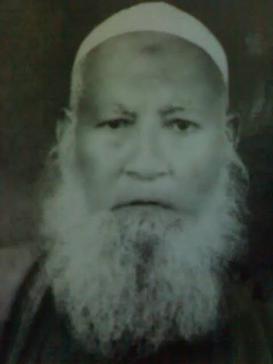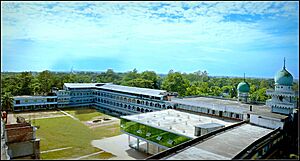Sultan Ahmad Nanupuri facts for kids
Quick facts for kids Sultan Ahmad Nanupuri |
|
|---|---|
| সুলতান আহমদ নানুপুরী | |
 |
|
| Religion | Islam |
| Denomination | Sunni |
| Alma mater | Darul Uloom Deoband |
| Personal | |
| Born | Shah Sultan Ahmad 26 June 1914 Dharmapur, Chittagong District, Bengal Province |
| Died | 16 August 1997 (aged 83) Al-Jamiah Al-Islamiah Obaidia Nanupur, Bangladesh |
| Spouse | Momena Khatun |
| Children | 2 |
| Religious career | |
| Teacher | Muhammad Faizullah Hussain Ahmed Madani Ibrahim Balyawi Izaz Ali Amrohi |
| Disciple(s) | Said Ahmad |
| Principal of Al-Jamiah Al-Islamiah Obaidia Nanupur | |
| In office 1958–1995 |
|
| Succeeded by | Zamiruddin Nanupuri |
Shah Sultan Ahmad Nanupuri (born June 26, 1914, died August 16, 1997) was a very respected Islamic scholar, teacher, and writer from Bangladesh. People also called him 'Badshah', which means 'King'. He started many Islamic schools, called madrasas, in Bangladesh. He was also the first principal of a big school named Al-Jamiah Al-Islamiah Obaidia Nanupur for 17 years.
Contents
Early Life and Family Background
Shah Sultan Ahmad was born on June 26, 1914. His family lived in a village called Dharmapur. This village was in the Chittagong District of the Bengal Province. His father, Shah Fazlur Rahman, worked in Rangoon, which is now in Myanmar. His mother, Umdah Khatun, stayed at home.
His family had a long history. His great-great-grandfather, Akbar Shah, came from Arabia. He traveled through Afghanistan to Bengal to share the message of Islam. He then settled there permanently. Sultan Ahmad was the only one of his father's children who lived past childhood. Sadly, when he was about two and a half years old, his mother passed away due to a sickness called cholera.
Learning and Education
Sultan Ahmad started his education at a local school called a maktab. It was run by a teacher named Ubaydul Haq Mianji. When he turned five, he went to Garzania Primary School. Later, his father told him to join the Himayah al-Islam Madrasa in Nanupur. There, he studied with teachers like Lal Miyan, Obaydul Hoque, and Muhammad Faizullah.
In his last year of study, his father died. After finishing at the madrasa, his stepmother suggested he go to the Darul Uloom Alia Madrasa in Chittagong city. Ahmad stayed there for a few months but did not like the way they taught. So, he went back home. His old teachers inspired him to join the Darul Uloom Deoband school. This school was in India. He traveled to Saharanpur in India to continue his studies there. He also studied for a short time at another school called Mazahir Uloom. He then finished his studies in Hadith (sayings of Prophet Muhammad) at Darul Uloom Deoband. He also started a course in philosophy. Some of his important teachers were Hussain Ahmad Madani, Izaz Ali Amrohi, and Ibrahim Balyawi.
His Work and Career
While studying in Deoband, Sultan Ahmad also worked as an imam (prayer leader) at the main mosque there. After he finished his studies and came back to Bengal, he wrote a letter to teach at a school called Al-Jamia al-Arabia Nasirul Islam in Nazirhat Bazar. They accepted him. Later, the principal of that school hired another scholar named Zafar Ahmad Usmani. Usmani supported a political group, but Sultan Ahmad believed that religious schools should not be involved in politics.
Because of this, Sultan Ahmad left that school. He then became a teacher at Al-Jamiatul Islamiah Azizul Uloom Babunagar for 15 years. Later, a scholar named Azizul Haq asked Sultan Ahmad to become the acting principal. Then, in 1961, he became the first principal of Al-Jamiah Al-Islamiah Obaidia Nanupur. He worked at Nanupur for 17 years. After that, he gave the role to Zamiruddin Nanupuri. Some of his well-known students were Abdur Rahman Chatgami and Muhibbullah Babunagari.
He also started other madrasas, like Al-Jamiah Al-Islamiyyah Bayt al-Huda. He also created a monthly magazine called Ar-Rashid.
Personal Life and Spiritual Journey
During his studies in Deoband, Sultan Ahmad spent seven years learning from Hussain Ahmad Madani. He made a special promise to Madani on November 18, 1944. After India was divided in 1947, it became hard for Sultan Ahmad to stay in touch with Madani. Madani wrote him a letter, allowing him to learn from another spiritual teacher. So, Sultan Ahmad became a student of Azizul Haq from Patiya. After 15 years, he received a special permission from Azizul Haq to guide others spiritually.
Sultan Ahmad went on his first Hajj (pilgrimage to Mecca) with his spiritual guide, Azizul Haq. In 1967, a businessman paid for his second Hajj trip. His third Hajj was in 1970, and his fourth and last Hajj was in 1991.
On January 21, 1945, Sultan Ahmad married Momena Khatun. She was the first daughter of Munshi Abdul Khaliq. They had four sons and six daughters. Sadly, two of their sons passed away when they were young. His son, Imdadullah Nanupuri, is also an Islamic scholar. He is the principal of Al-Jamiah Al-Islamiyyah Bayt al-Huda.
Death and Lasting Impact
Sultan Ahmad Nanupuri passed away on August 16, 1997. He had been ill for three years. He died in his room at Al-Jamiah Al-Islamiah Obaidia Nanupur. The next day, Ali Ahmad Boalvi led his funeral prayer at the Nanupur Madrasa. Sultan Ahmad's oldest son, Hussain Ahmad Nanupuri, was not there because he was in the United Arab Emirates. So, when he returned, Sultan Ahmad's younger son, Imdadullah Nanupuri, led a second funeral prayer. After the prayer, Sultan Ahmad was buried in a place called Maqbara-e-Sultania.
His main spiritual student, Said Ahmad, started a madrasa in Feni named after him. It is called Al-Jamiah al-Islamiyyah as-Sultaniyyah. Said Ahmad also wrote a book about his teacher called "Shah Sultan Ahmad Nanupuri's life and teachings". Another scholar, Shah Ahmad Ghani, also wrote a book about him. A very long book about Sultan Ahmad, in eleven parts, was written in Urdu. It was later edited and published in two parts.
His students have created many groups and schools in his name. For example, there is the Allama Shah Sultan Ahmad Foundation Bangladesh. His speeches have also been collected and published in books. In 2018, Al-Jamiah Al-Islamiyyah Bayt al-Huda started publishing a magazine named Samayiki As-Sultan.
Other books written about him include:
- Hayat-e-Nanupuri Rah. (1999) by Professor Munawwar
- Nanupuri Rah. Er Jibon O Dorshon (2000) by Imdadullah Nanupuri
- Fuyuz-e-Sultani (2005) by Mawlana Rafiq
- Kemon Chilen Nanupuri (2008) by Mahmudul Hasan
- Mawayez-e-Sultan (2008) by Mufti Moinuddin
- Malfuzat-e-Nanupuri


